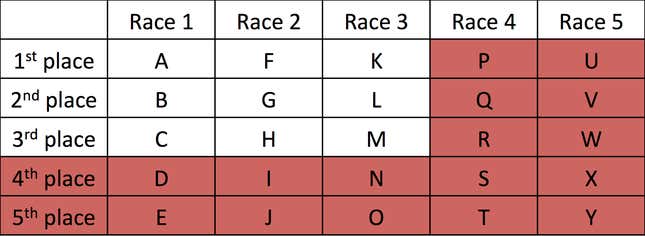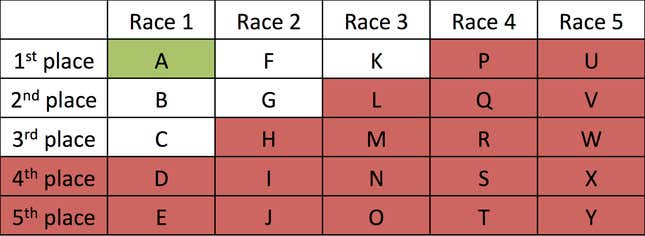A coin flip is the quintessence of fifty-fifty chance, but a large group of researchers recently overturned its equitable reputation. Recording a painstaking 350,000+ coin flips by hand, they found that almost 51% of tosses land with the same side facing upward as before the flip (i.e. if the coin shows heads at the start when perched on your thumb, then it is more likely to land heads, and the same goes for tails). If you’re looking for your next binge-watch, the researchers taped every flip and made the footage publicly available.
With so many data points, the results are statistically significant and deal a blow to bar bets and NFL kickoffs forevermore. Fortunately, the group tested a variety of coins and found no preference for heads vs. tails. So you can restore the sanctity of a fair coin toss by concealing its starting orientation from the person who calls it.
Spinning a coin seems even worse. Some work has found that spinning pennies are much more likely to land tails-up. Next time your friend wants to settle something by flipping a coin, maybe suggest spinning a penny instead. Remember to call tails.
Did you miss last week’s puzzle? Check it out here, and find its solution at the bottom of today’s article. Be careful not to read too far ahead if you haven’t solved last week’s yet!
Puzzle #27: Heads Up
You and I are going to settle something with a coin flip. Instead of an ordinary coin flip, you’ll call either “HHT” or “THH”. Then we’ll flip the coin multiple times in a row and record the results. If the sequence heads, heads, tails occurs first, then HHT wins, and if the sequence tails, heads, heads occurs first, then THH wins. We keep flipping until one of them occurs.
Which do you call? Or does it not matter?
What is the probability that each wins?
The coin is fair and is equally likely to turn up heads or tails on any given flip.
I’ll be back next Monday with the answer and a new puzzle. Do you know a cool puzzle that you think should be featured here? Message me on Twitter @JackPMurtagh or email me at gizmodopuzzle@gmail.com
Solution to Puzzle #26: Horsing Around
Did you pass last week’s Google interview question?
A stable has 25 horses. You can race five horses of your choice at a time and learn who won, who came in second, etc.. You don’t learn how fast they ran, only what place the five horses got relative to each other. What is the minimum number of races you’ll need to identify the three fastest horses of the 25?
You’ll need seven races. Shout-out to Lions-Eye Sea-Rear for accompanying your correct solution with a nice visual aid.
When I posed the problem, I said that you don’t need to discover the rank order of the fastest three. Several of you correctly pointed out that the solution with seven races does also tell you the order of the top three. That was an oversight and I apologize if my unneeded clarification mislead any of you.
Here’s how to do it in seven races. Every horse needs to participate in a race at some point, because if you leave a horse untested, you’ll never know if it was in the top three or not. So start with five races where each horse participates in one of them. You learn the results of the races and can make a table like this, where each letter represents a different horse.
Every horse that got 4th or 5th place in their race can be eliminated from consideration because we already know three horses that are faster than them. For example, horse N cannot be one of the three fastest horses because horses K, L, and M are all faster than N (they all beat N in race 4). Horse R, on the other hand, could be in the top three, because for all we know P, Q and R are the three fastest horses. We have no evidence to the contrary until we conduct further races.
For our 6th race, we’ll compare the five horses that got first place in their respective race, i.e. we’ll pit horses A, F, K, P, and U against each other. Suppose the results are in alphabetical order:
A > F > K > P > U (A gets first, F gets second, and so on).
Now we can eliminate horses P and U from contention because we know three horses that are faster than P and U (A, F, and K). Furthermore, we can eliminate any horse that has lost a race to P and U (if P doesn’t crack the top three, then surely a horse that loses to P doesn’t either).

Race 6 also allows us to eliminate horses H, L, and M because we can name three horses that are faster than them. For example, L loses to K (Race 3) and K loses to A and F (Race 6). Race 6 also taught us that A is the fastest horse of all. How do we know that? Could G be faster than A, for example? No, because A is faster than F (race 6) and F is faster than G (race 2). Horse A winning first place among the first place horses crowns him the overall winner, but we still need to find the next two.

Luckily, only five horses remain to test so we can learn the second and third fastest horses by comparing B, C, F, G, and K in Race 7.
Trending Products















